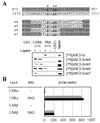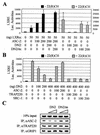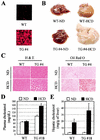Activating signal cointegrator 2 required for liver lipid metabolism mediated by liver X receptors in mice
- PMID: 12724417
- PMCID: PMC164762
- DOI: 10.1128/MCB.23.10.3583-3592.2003
Activating signal cointegrator 2 required for liver lipid metabolism mediated by liver X receptors in mice
Abstract
Activating signal cointegrator 2 (ASC-2), a cancer-amplified transcriptional coactivator of nuclear receptors and many other transcription factors, contains two LXXLL-type nuclear receptor interaction domains. Interestingly, the second LXXLL motif is highly specific to the liver X receptors (LXRs). In cotransfection, DN2, an ASC-2 fragment encompassing this motif, exerts a potent dominant-negative effect on transactivation by LXRs, which is rescued by ectopic coexpression of the full-length ASC-2 but not by other LXXLL-type coactivators, such as SRC-1 and TRAP220. In contrast, DN2/m, in which the LXXLL motif is mutated to LXXAA to abolish the interactions with LXRs, is without any effect. Accordingly, expression of DN2, but not DN2/m, in transgenic mice results in phenotypes that are highly homologous to those previously observed with LXRalpha(-/-) mice, including a rapid accumulation of large amounts of cholesterol and down-regulation of the known lipid-metabolizing target genes of LXRalpha in the liver upon being fed a high-cholesterol diet. These results identify ASC-2 as a physiologically important transcriptional coactivator of LXRs and demonstrate its pivotal role in the liver lipid metabolism.
Figures






Similar articles
-
Characterization of ASC-2 as an antiatherogenic transcriptional coactivator of liver X receptors in macrophages.Mol Endocrinol. 2009 Jul;23(7):966-74. doi: 10.1210/me.2008-0308. Epub 2009 Apr 2. Mol Endocrinol. 2009. PMID: 19342446 Free PMC article.
-
Activating signal cointegrator-2 is an essential adaptor to recruit histone H3 lysine 4 methyltransferases MLL3 and MLL4 to the liver X receptors.Mol Endocrinol. 2008 Jun;22(6):1312-9. doi: 10.1210/me.2008-0012. Epub 2008 Mar 27. Mol Endocrinol. 2008. PMID: 18372346 Free PMC article.
-
Characterization of activating signal cointegrator-2 as a novel transcriptional coactivator of the xenobiotic nuclear receptor constitutive androstane receptor.Mol Endocrinol. 2005 Jul;19(7):1711-9. doi: 10.1210/me.2005-0066. Epub 2005 Mar 10. Mol Endocrinol. 2005. PMID: 15764585
-
LuXuRies of lipid homeostasis: the unity of nuclear hormone receptors, transcription regulation, and cholesterol sensing.Mol Interv. 2002 Apr;2(2):78-87. doi: 10.1124/mi.2.2.78. Mol Interv. 2002. PMID: 14993353 Review.
-
Liver X receptors (LXRs). Part I: structure, function, regulation of activity, and role in lipid metabolism.Postepy Hig Med Dosw (Online). 2007 Dec 3;61:736-59. Postepy Hig Med Dosw (Online). 2007. PMID: 18063918 Review.
Cited by
-
Coactivators in PPAR-Regulated Gene Expression.PPAR Res. 2010;2010:250126. doi: 10.1155/2010/250126. Epub 2010 Aug 5. PPAR Res. 2010. PMID: 20814439 Free PMC article.
-
Regulation of insulin secretion and beta-cell mass by activating signal cointegrator 2.Mol Cell Biol. 2006 Jun;26(12):4553-63. doi: 10.1128/MCB.01412-05. Mol Cell Biol. 2006. PMID: 16738321 Free PMC article.
-
Roles of histone H3-lysine 4 methyltransferase complexes in NR-mediated gene transcription.Prog Mol Biol Transl Sci. 2009;87:343-82. doi: 10.1016/S1877-1173(09)87010-5. Epub 2009 Oct 7. Prog Mol Biol Transl Sci. 2009. PMID: 20374709 Free PMC article. Review.
-
Identification and characterization of the alternatively spliced nuclear receptor coactivator-6 isoforms.Int J Biol Sci. 2011 Apr 19;7(5):505-16. doi: 10.7150/ijbs.7.505. Int J Biol Sci. 2011. PMID: 21552418 Free PMC article.
-
Orphan nuclear receptor DAX-1 acts as a novel corepressor of liver X receptor alpha and inhibits hepatic lipogenesis.J Biol Chem. 2010 Mar 19;285(12):9221-32. doi: 10.1074/jbc.M109.073650. Epub 2010 Jan 15. J Biol Chem. 2010. PMID: 20080977 Free PMC article.
References
-
- Barclay, T. B., J. M. Peters, M. B. Sewer, L. Ferrari, F. J. Gonzalez, and E. T. Morgan. 1999. Modulation of cytochrome P-450 gene expression in endotoxemic mice is tissue specific and peroxisome proliferator-activated receptor-alpha dependent. J. Pharmacol. Exp. Ther. 290:1250-1257. - PubMed
-
- Berge, K. E., H. Tian, G. A. Graf, L. Yu, N. V. Grishin, J. Schultz, P. Kwiterovich, B. Shan, R. Barnes, and H. H. Hobbs. 2000. Accumulation of dietary cholesterol in sitosterolemia caused by mutations in adjacent ABC transporters. Science 290:1771-1775. - PubMed
-
- Bucolo, G., and H. David. 1973. Quantitative determination of serum triglycerides by the use of enzymes. Clin. Chem. 19:476-482. - PubMed
-
- Caira, F., P. Antonson, M. Pelto-Huikko, E. Treuter, and J. A. Gustafsson. 2000. Cloning and characterization of RAP250, a novel nuclear receptor coactivator. J. Biol. Chem. 275:5308-5317. - PubMed
Publication types
MeSH terms
Substances
LinkOut - more resources
Full Text Sources
Other Literature Sources
Molecular Biology Databases
Miscellaneous
